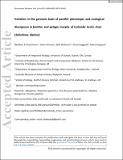Files in this item
Variation in the genomic basis of parallel phenotypic and ecological divergence in benthic and pelagic morphs of Icelandic Arctic charr (Salvelinus alpinus)
Item metadata
| dc.contributor.author | Brachmann, Matthew K. | |
| dc.contributor.author | Parsons, Kevin | |
| dc.contributor.author | Skúlason, Skúli | |
| dc.contributor.author | Gaggiotti, Oscar | |
| dc.contributor.author | Ferguson, Moira | |
| dc.date.accessioned | 2023-08-02T23:38:32Z | |
| dc.date.available | 2023-08-02T23:38:32Z | |
| dc.date.issued | 2022-09-01 | |
| dc.identifier | 280560693 | |
| dc.identifier | 53e7e046-aae5-4c1c-9b9f-a6000ca1f78a | |
| dc.identifier | 85135251765 | |
| dc.identifier | 000835802200001 | |
| dc.identifier.citation | Brachmann , M K , Parsons , K , Skúlason , S , Gaggiotti , O & Ferguson , M 2022 , ' Variation in the genomic basis of parallel phenotypic and ecological divergence in benthic and pelagic morphs of Icelandic Arctic charr ( Salvelinus alpinus ) ' , Molecular Ecology , vol. 31 , no. 18 , pp. 4688-4706 . https://doi.org/10.1111/mec.16625 | en |
| dc.identifier.issn | 0962-1083 | |
| dc.identifier.other | RIS: urn:C25BC25B70650655552D2BC479E620B6 | |
| dc.identifier.other | ORCID: /0000-0003-1827-1493/work/116910431 | |
| dc.identifier.uri | https://hdl.handle.net/10023/28089 | |
| dc.description.abstract | Sympatric adaptive phenotypic divergence should be underlain by genomic differentiation between subpopulations. When divergence drives similar patterns of phenotypic and ecological variation within species we expect evolution to draw on common allelic variation. We investigated divergence histories and genomic signatures of adaptive divergence between benthic and pelagic morphs of Icelandic Arctic charr. Divergence histories for each of four populations were reconstructed using coalescent modelling and 14,187 single nucleotide polymorphisms. Sympatric divergence with continuous gene flow was supported in two populations while allopatric divergence with secondary contact was supported in one population; we could not differentiate between demographic models in the fourth population. We detected parallel patterns of phenotypic divergence along benthic-pelagic evolutionary trajectories among populations. Patterns of genomic differentiation between benthic and pelagic morphs were characterized by outlier loci in many narrow peaks of differentiation throughout the genome, which may reflect the eroding effects of gene flow on nearby neutral loci. We then used genome-wide association analyses to relate both phenotypic (body shape and size) and ecological (carbon and nitrogen stable isotopes) variation to patterns of genomic differentiation. Many peaks of genomic differentiation were associated with phenotypic and ecological variation in the three highly divergent populations, suggesting a genomic basis for adaptive divergence. We detected little evidence for a parallel genomic basis of differentiation as most regions and outlier loci were not shared among populations. Our results show that adaptive divergence can have varied genomic consequences in populations with relatively recent common origins, similar divergence histories, and parallel phenotypic divergence. | |
| dc.format.extent | 19 | |
| dc.format.extent | 1383428 | |
| dc.language.iso | eng | |
| dc.relation.ispartof | Molecular Ecology | en |
| dc.subject | Adaptation | en |
| dc.subject | Population genomics | en |
| dc.subject | Fish | en |
| dc.subject | Resource polymorphism | en |
| dc.subject | Adaptive divergence | en |
| dc.subject | Parallel evolution | en |
| dc.subject | GC Oceanography | en |
| dc.subject | QH301 Biology | en |
| dc.subject | DAS | en |
| dc.subject | MCC | en |
| dc.subject.lcc | GC | en |
| dc.subject.lcc | QH301 | en |
| dc.title | Variation in the genomic basis of parallel phenotypic and ecological divergence in benthic and pelagic morphs of Icelandic Arctic charr (Salvelinus alpinus) | en |
| dc.type | Journal article | en |
| dc.contributor.institution | University of St Andrews. School of Biology | en |
| dc.contributor.institution | University of St Andrews. Scottish Oceans Institute | en |
| dc.contributor.institution | University of St Andrews. St Andrews Bioinformatics Unit | en |
| dc.contributor.institution | University of St Andrews. Marine Alliance for Science & Technology Scotland | en |
| dc.identifier.doi | 10.1111/mec.16625 | |
| dc.description.status | Peer reviewed | en |
| dc.date.embargoedUntil | 2023-08-03 |
This item appears in the following Collection(s)
Items in the St Andrews Research Repository are protected by copyright, with all rights reserved, unless otherwise indicated.

